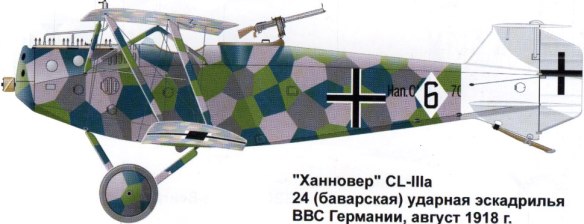The German company Hannoversche Waggonfabbrik AG was a long-time producer of horse wagons and railway cars. At the outbreak of WWI, the German air ministry requested that they become a sub-contractor for the aviation industry. Several of the projects they worked on included the Aviatik C.I, the Rumpler C.Ia, and the Halberstadt D.II. When in early 1917, a new spec was issued for a new category of “CL” aircraft, Hannover figured that they had gained enough experience to produce their own prototype. The “C” class was intended to act as an artillery spotter, or recon aircraft, however they were typically slow and sitting ducks for fighters, so the new “CL” class was designed to operate as escorts that were adequately armed to fight off attackers.
The Hannover CL III was a development of the CL II, having the same layout. It was produced in response to criticism from crews in the field about a lack of lateral control at low altitudes. The wingtips were modified, and the ailerons were changed incorporating overhanging balances, which helped fix the issue. This modification was important because the role of the aircraft was changed to that of a ground attack fighter. The performance was also improved by installing the 160hp Mercedes engine, which was lighter and although rated lower in horsepower, actually performed better, particularly at altitude. Unfortunately, the Mercedes engine was required more urgently for single seat fighters, so the type reverted to the Argus engine, and in this configuration, was designated the CL.IIIa. All other aspects of the new model seem to be similar to the CL.II.
Variants
Hannover CL.III
Powered by a 119-kW (160-hp) Mercedes D.III engine.
Hannover CL.IIIa
CL III powered by a 134-kW (180-hp) Argus As.III engine
Hannover CL.IIIb
Experimental model of the CL.III, with a two-bay wing.
Specifications (CL.IIIa)
General characteristics
Crew: 2
Length: 7.58 m (24 ft 10 in)
Wingspan: 11.7 m (38 ft 5 in)
Height: 2.8 m (9 ft 2 in)
Wing area: 32.7 m2 (352 sq ft)
Empty weight: 717 kg (1,581 lb)
Gross weight: 1,081 kg (2,383 lb)
Powerplant: 1 × Argus As III 6-cyl. water-cooled in-line Piston engine, 130 kW (180 hp) (CL.IIIa)
or 1x 119.3 kW (160 hp) Mercedes D.III (CL.III)
Performance
Maximum speed: 165 km/h (103 mph; 89 kn) at 5,000 m (16,404 ft)
Endurance: 3 hours
Service ceiling: 7,498 m (24,600 ft)
Rate of climb: 3.145 m/s (619.1 ft/min)
Time to altitude: 1,000 m (3,281 ft) in 5 minutes 18 seconds
Armament
Guns: 3 × 7.92 mm (0.323 in) LMG 08/15 machineguns (two ring-mounted in observer’s cockpit, one fixed forward)
